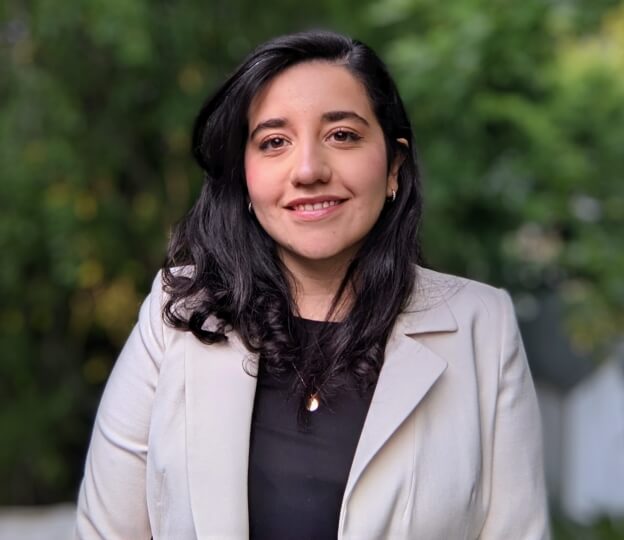Mitsue Elisa Guerrero Monsalve, M.D.E. ’20
Mitsue Elisa Guerrero Monsalve has always loved to design things. After graduating with a degree in industrial design as an undergraduate from the Instituto Tecnológico y de Estudios Superiores de Monterrey, she worked as lead design strategist in Mexico City. She found the experience of working with several major international companies interesting, but not quite fulfilling.
“I learned a lot and loved my time and the people there, but I felt like the actual impact was missing,” Guerrero said. “I wanted impact to be measured in the number of lives that we were making better, and not just in how much money companies were making.”
A desire to combine design principles with social impact brought her to the Master in Design Engineering program run jointly by the Harvard John A. Paulson School of Engineering and Applied Sciences (SEAS) and Harvard Graduate School of Design. The native of Mexico came to Harvard as a Fulbright Scholar and centered her studies around climate change adaptation, interning with the World Wide Fund for Nature (WWF) while on campus. She went on to work for the WWF after graduation, and then work as a contractor with the United Nations Framework Convention on Climate Change (UNFCCC).
“I wanted to expand the knowledge base that I had and not just stick with the design background. I had the goal of finding ways to create impact on one of the biggest challenges of our time, climate change,” said Guerrero, M.D.E. ’20. ”The first class I tried this with was International Environmental Law at Harvard Law School. The more I understood how many environmental policy decisions were taken from an economic perspective instead of an environmental perspective, the more I realized how complex the topic of climate change was. It’s a topic I never stop learning about, which makes it super entertaining.”
She was part of the third graduating class of the M.D.E. program. The program allows students to take a very multidisciplinary approach to their education, which for Guerrero “meant taking as many climate change classes in as many Harvard schools as possible. She also got involved with multiple climate- and sustainability-related organizations here, such as the Harvard Graduate Consortium on Energy and Environment, Harvard Climate Leaders Program, Circular Economy Symposium at Harvard, and Student Climate Change Conference at Harvard.
“I took the Leadership in Environmental Conflicts course at Harvard Kennedy School, and the Sustainable Cities and Climate Adaptation class at Harvard Business School, as well as many classes in the GSD and SEAS on energy, water, geoengineering and other topics,” she said. “I could shape my degree by showing that designers, engineers and people from different backgrounds can challenge themselves into new disciplines to collaborate and innovate.”
Guerrero’s work at the UNFCCC centers around supporting climate change adaptation plans in Least Developed Countries (LDC), a U.N. classification based on factors such as school enrollment, infant and maternal mortality, and annual income. Because LDCs lack the infrastructure and resources of more developed nations, adapting to confront climate change is even more difficult. One of Guerrero’s main responsibilities was creating and updating websites to more easily show how these nations are progressing with their national adaptation plans.
“Adaptation in climate change is about creating resilience in all the systems of a country,” Guerrero said. “With the food system in an agricultural economy, that would mean encouraging the cultivation of crops that are very resilient to drought or floods, finding ways to diversify income and livelihoods by sustainably using other ecosystem services like responsible beekeeping, or better food storage and preservation methods to ensure food security. But adaptation could also mean reinforcing health systems, such as having hospitals with refrigeration methods for vaccines and supplies that aren’t solely dependent on systems that could collapse in a hurricane or other major disaster, such as power supplies or roads.”
Running these UNFCCC websites tapped into so much of what Guerrero loves about design engineering. It requires technical skills such as computer programming, visual communication skills such as data visualization, and interpersonal skills as she collaborates with various climate change experts. Her work benefitted from her previous position as an Initiative Innovation Strategist at the WWF, where she co-designed the evolution of a program focusing on nature-based solutions for climate adaptation in Sub Saharan Africa.
“Communicator and collaborator are the roles I tend to play within organizations,” Guerrero said. “My climate science expertise allows me to communicate with other climate professionals who aren’t designers to better express their concerns, find creative opportunities for impact, and co-create a strategy.”
Guerrero is now an associate design director of circular design at McKinsey. Circular design focuses on sustainability and environmentally friendly production; it involves rethinking the products we use to meet our needs, the number of resources used for those products, and reducing the amount of waste generated by those products.
“It’s time for action, and I want to help the private and public sector in the implementation of those policies that I worked on during my time at UNFCCC and WWF,” she said.
It’s an entirely different approach to climate change and sustainability from her work with the UNFCCC, which for Guerrero recalls a mindset she learned while at Harvard.
“In design engineering, you didn’t know what the final product would be,” she said. “The end result could be a strategy, a service, an experience, a digital or physical product, or a mix of everything. That was one of the best things about the program: because I didn’t know what the final product would be, I could stay open to really hear the insights and opportunity areas to be addressed.”
Press Contact
Matt Goisman | mgoisman@g.harvard.edu
